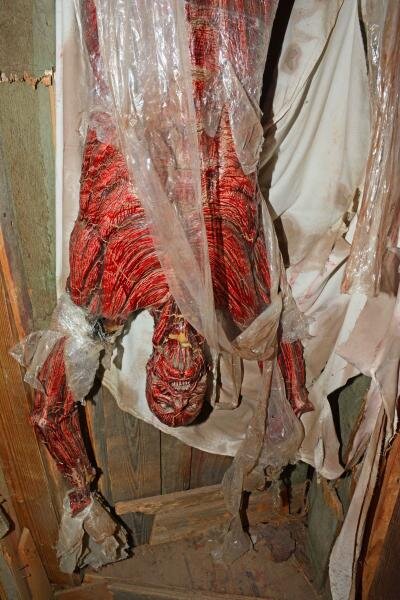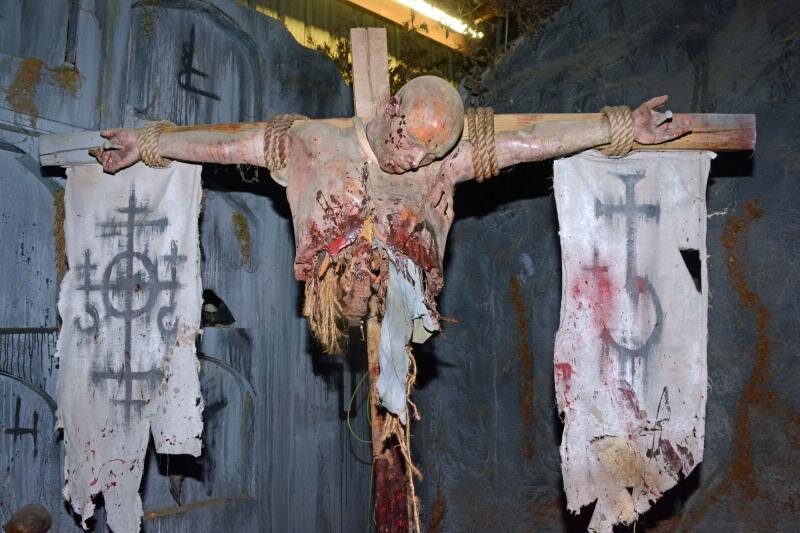Shuttering the House of Shock
A 22-year reign of terror comes to an end
The world will be a slightly less frightening place. After Halloween, The House of Shock--voted the number one haunted house in the U.S. by Haunted Attraction Magazine—has been scaring the bejesus out of people for 22 years now. But this will be their last season. At the end of the evening this Saturday, November 1, the House of Shock will close its spooky doors for good.
More than a simple haunted house, the House of Shock is a self-proclaimed “interactive haunted house and Halloween festival,” complete with live music and entertainment, a full bar and food for purchase, over-the-top pyrotechnics, a pseudo-Satanic church, and all kinds of ghosts, demons, vampires, zombies, crazies, and other things undead and unholy.
Guests begin their visit watching a theatrical stage show where good battles evil, which culminates in a display of fireworks and hellfire. The patrons then enter the haunted house, where they wander through a terrifying labyrinth of dark and disturbing scenes, including the French Quarter, a swamp, a toxic waste dump and a voodoo shop. There are dismembered body parts galore, piles of bones, and little girls in cages. All the while, dressed-up, made-up freaks scream and moan and attempt to stun visitors into a fear-induced coma.
Says Ross Karpelman, co-founder, owner, and entertainer of the House of Shock, “It’s such a charge, and it’s so much fun to scare people. Seeing that reaction and scaring the hell out of somebody is probably one of the most fun things you can ever do. Have you ever hidden behind a wall and jumped out and scared somebody? This is something you'll laugh about for at least 45 minutes. Well that’s an entire evening for us.”
Yes, Karpelman and his creepy cohorts do this for the sheer joy of it. It’s one big gruesome party for them. He says, “We do this because we find it to be funny and fun and enjoy every second of it. We’re still having a blast.” Karpelman has a staff of 300-plus men, women, and even children (the youngest of whom is under two) who share this love of the scare. They offer their time to the cause on a purely volunteer basis. It is the camaraderie of his workers, which he sees as an extended family, that Karpelman claims he is going to miss the most. You can definitely get a real feel for their companionship and community spirit watching the crew behind the scenes as they share a joke, a beer, or a Halloween cookie, while psyching themselves up for hours of spooking. Says Karpelman, “It's way more than a haunted house for our people here. This is family. It’s also the passion of putting together this production. We never did this for money. This was never something we were going to get rich on.”
That has been particularly true in recent years. Hurricane Isaac a couple years ago hurt, as did the fact that Halloween itself was rainy last year, and prevented the House of Shock from opening on the biggest day of its short season. But it’s not just about the money. Karpelman lists other reasons for throwing in the blood-soaked towel.
“I think most of all we’ve reached the pinnacle of the theme and what we’re known for,” he says. The House of Shock has become an industry leader in the world of the "interactive" haunted house—a concept which Karpelman and his co-founders take credit for inventing. It wasn't until the House of Shock that guests would actually walk among the dead, sharing the same dark, cramped and hellish quarters. Says Karpelman, "I think the days of the velvet ropes separating your cast from your clients are over. We're starting to see a lot of people mingling with their patrons."
Of course, his kind of "mingling" means having horrifying creatures jump out at patrons, grab at heir feet or come at them with chainsaws.
The House of Shock started in someone’s backyard, more than two decades ago, and it now has thousands who come to see it each night. "Once we were the black sheep and called crazy for trying to do this," says Karpelman. "Now you are starting to see a lot of events that are employing this interactive doctrine as a method for scaring people."
Besides 22 years of scares and horror, the House of Shock has been the scene of marriages and births, movie productions and heavy metal concerts. But they prefer to quit while they’re ahead. “It’s time to call it quits while we’re still on top," Karpelman says. "I don’t want to fizzle out. It’s time to retire the concept.”
Not all the attention the House of Shock has drawn over the years has been positive. Karpelman always gets a kick out of the reactions from guests that he has witnessed, which range from the petrified to irate. The faux-Satanic themes featured particularly in the notorious Church of Sadness, and throughout the attraction have caused controversy. Certain parents, politicians, school officials, and those among the group of what Karpelman refers to as “hardcore abortion-clinic-bombing Christians“ have protested against the haunted house. Every night he portrays a blasphemous anti-Christ known as Lord Belial, and once was threatened with bodily harm from an empty water bottle by one very agitated and religious patron.
Yet by far, the most common response is simply fright. The House of Shock is clearly not for the faint of heart. When asked what the creep factor of the place really is, Karpelman says, “I would say we're a 15. We’re certainly the most intense haunted attraction in the industry. You can't get more intense than us unless you're physically killing people.” And that has happened. One old lady visitor fell dead of a heart attack five feet before the exit. Fortunately, medics were able to revive her.
Karpelman invites everyone to come out for one last scare before it’s too late. “This is something that you've got to see. We got music. We got freak show acts. We have a large stage show with so much pyro." He jokes that it’s really the extreme pyrotechnics that burned all his hair off and left him bald.
“And then you go inside and it’s just intensity ;coming from all angles. You will never, ever, ever see anything like this anywhere else in the world. It’s uniquely New Orleans.”
But only for a few more days.

